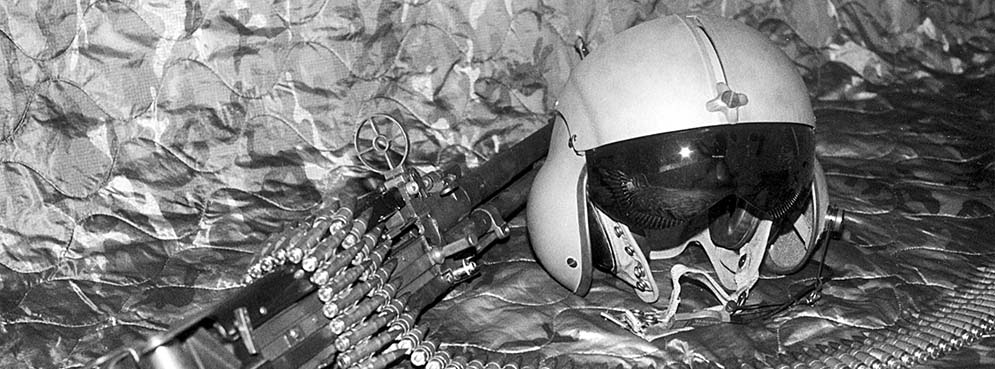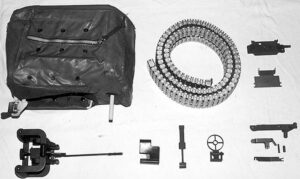By Dudley Calfee
This LZ was “hot.” As the UH1 “Huey” helicopter approached the clearing, the door gunner could see the flashes of automatic weapons fire and occasional tracer rounds coming from the tree line. He swung his M60 towards the tree line and began firing. Trying to ignore the incoming fire, the gunner tried to concentrate on the job at hand. “Keep their heads down,” he thought as he fired towards the flashes . A small group of US soldiers began their dash across the open field as the pilot of the Huey brought the aircraft to a quick landing in the tall grass. The enemy fire subsided as the battle weary patrol threw themselves into the open door of the helicopter. The pilot applied full power and dipped the nose of the craft for a quick exit from the clearing. The fire from the enemy erupted again and the gunner resumed chopping the tree line with the ’60. The gunner could see the enemy troops running out of the cover of the jungle, firing at the helicopter as it rose to clear the trees at the far end of the field.
One of the most enduring images of the Vietnam War is that of an M60 gunner shooting from the open door of a Huey helicopter. The M60 machine gun was used in this role to provide fire support at landing zones or “LZ’s” and also to support ground troops attempting to take an objective.
The first M60’s used in Hueys were simply hung from the framework of the helicopter with bunji cords. This arrangement was a “field expedient” solution to get some firepower on board the chopper. It was soon discovered that the gunner, by having to shoulder the M60, was exposed to enemy fire and subject to the movement of the chopper, resulting in high casualty rates for door gunners and poor hit probability. Brass and links coming from the gun were also a problem, causing slippery footing on the deck of the aircraft and probably more than a few welts on the crew from the fast flying ejectate. Feeding the gun was also a problem because of the unsupported weight of the belted ammo and the tendency of the belt to kink when the weapon was swung from side to side. You can frequently see another ‘field expedient’ solution to this problem in the form of a C-ration can wired to the feed tray to help the belted ammo make a smoother entrance into the gun.
The solution to the shortcomings of the basic M-60 was a series of modifications resulting in the M60-D. The D conversion kit gave the gunner a more accurate and reliable weapon. The “D” kit consists of spade grips which replaced the buttstock, a modified trigger group which attaches to the spade grips by means of a long operating rod, an aircraft style “spider” sight which replaces the rear sight, and an “ejection control” bag to catch the links and brass ejected from the gun. An adapter, which fits between the forend mounting pin and the pintle pin mounting holes, is the mounting point for the “ejection control” bag. The gun is attached by the pintle pin to a more suitable pedestal mount which was bolted to the floor of the aircraft. This arrangement provides a more stable platform for the machine gun and also included traverse limit stops to prevent the gun from swinging too far to the left or right. A quick release pin was provided to attach the gun to its mount. Feed problems were solved by adding a flexible feed chute which guided the linked ammunition from the ammo box to the gun. The front handguard of the weapon was removed which, helped by the slipstream effect of the airflow around the Huey, aided in cooling the barrel.
Converting a standard M60 to “D” configuration is a fairly simple process. First, the weapon is cleared and stripped of its buttstock, trigger group, handguard and handguard mounting pin, and rear sight.
The only permanent alteration to the gun is to rivet or screw the feed chute bracket to the left side of the receiver. The sear, spring and plunger, from the original trigger group are then installed in the “D” trigger housing. The “D” housing has a proprietary sliding crossbolt safety that is unique to the “D” setup. The “D” trigger group also has a smaller trigger pin necessitating the use of a sleeve and different trigger group retaining leaf spring. The “D” trigger group is installed in the receiver in the same manner as the original. The spade grips, along with a rubber-like filler piece, are installed in place of the buttstock and held in place by a long screw which threads into the receiver of the gun.
The transfer bar which actuates the trigger is clipped into place and adjusted for function by shortening or lengthening the rod by means of a threaded connection between the forward clip portion of the rod and the rear which attaches to the spade grips. The ejection control bag mounting bracket is installed between the forend mounting pin and the pintle pin holes and retained by the quick release pin. The rear sight is replaced with the “aircraft” style spider sight. The ejection control bag is slid over its front mounting bracket and locked into place by a clip that attaches to the T&E mounting point behind the trigger group.
Shooting the M60-D is somewhat different than shooting a standard M60. Since the shooter does not shoulder the weapon, the muzzle of gun has a tendency to “flip” upwards when fired. This results in the first few rounds going high until the gunner has the time to correct for the flip. Since the rear sight is now a spider type sight, and the gunner’s position is far behind the weapon exact aiming is not as easy. The gunner tends to shoot at a particular “area”, not at an exact spot. This is fine for the purpose of thrashing a tree line to suppress enemy fire, but not so effective at taking out specific targets. The gunner must correct his fire by watching the trajectory of the tracer rounds, loaded every fifth round in the belt.
The ejection control bag works well in catching the brass and links form the gun and can hold about 400 to 500 rounds before it must be emptied through zippered openings in the bag. There is also a zippered opening in the back of the bag to allow the gun to be cocked. The catch bag is convenient for recreational shooters who wish to save their brass and links.
One of the more unique uses of the M60-D was in the movie “Red Dawn.” Armorers for the film used an M60-D rigged up to look like a Soviet heavy machine gun. The addition of barrel cooling fins, a tall front sight post and a “stop sign” type flash hider made the ’60 look like a passable RPD. The modified M60-ED can be seen several times in the film, usually with the character “Erica,” played by Lea Thompson, as the gunner.
The M60-D is a functional and unique accessory for the collector who owns the host M60. Most of the parts for the M60-D conversion can be found on the surplus market. The ejection control bag and frame tend to be a bit rare, but examples of these come up for sale from time to time. The “D” kit can be purchased for around $600, plus the cost of the catch bag.
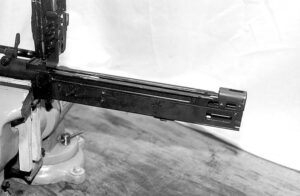
1. Stripped receiver with top cover in place. 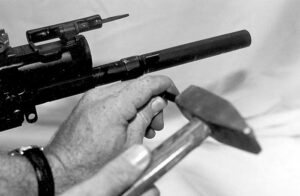
2. Removing the front handguard pin to allow installation of the ejection control bag adapter. 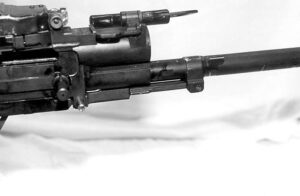
3. Ejection control bag adapter installed. 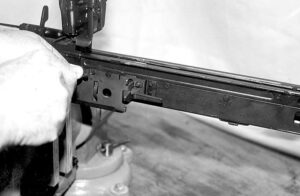
4. Screwing the receiver feed chute adapter in place. 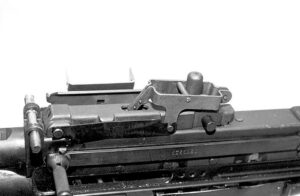
5. Receiver group installed. (Receiver is upside down) 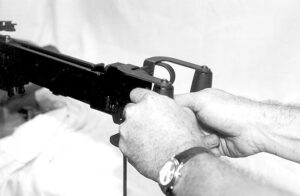
6. Installing spade grips. 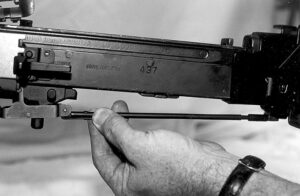
7. Locking the trigger bar in place. 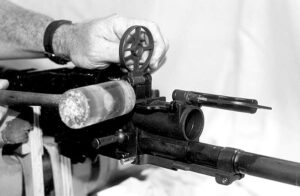
8. Installing rear “spider” sight. 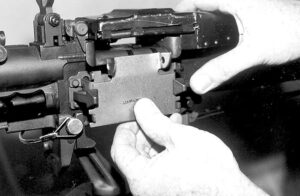
9. Installing the feed chute adapter plate. 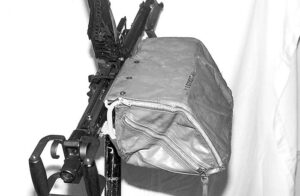
10. Ejection control bag installed. 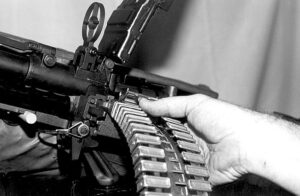
11. Installing the feed chute. 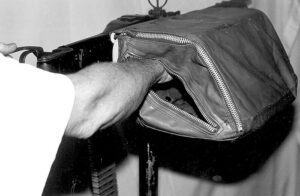
12. Cocking weapon through zippered opening in ejection control bag. 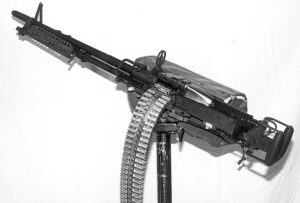
| This article first appeared in Small Arms Review V4N2 (November 2000) |



